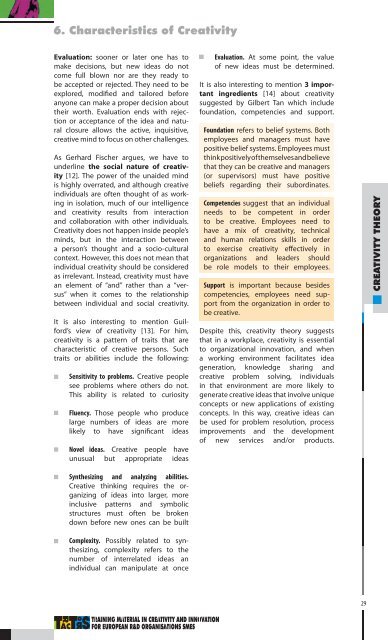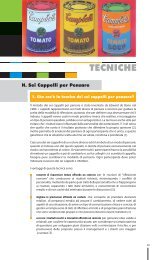Creativity Theory - TRaining MAterial in Creativity and InnovaTion ...
Creativity Theory - TRaining MAterial in Creativity and InnovaTion ...
Creativity Theory - TRaining MAterial in Creativity and InnovaTion ...
Create successful ePaper yourself
Turn your PDF publications into a flip-book with our unique Google optimized e-Paper software.
6. Characteristics of <strong>Creativity</strong><br />
Evaluation: sooner or later one has to<br />
make decisions, but new ideas do not<br />
come full blown nor are they ready to<br />
be accepted or rejected. They need to be<br />
explored, modified <strong>and</strong> tailored before<br />
anyone can make a proper decision about<br />
their worth. Evaluation ends with rejection<br />
or acceptance of the idea <strong>and</strong> natural<br />
closure allows the active, <strong>in</strong>quisitive,<br />
creative m<strong>in</strong>d to focus on other challenges.<br />
As Gerhard Fischer argues, we have to<br />
underl<strong>in</strong>e the social nature of creativity<br />
[12]. The power of the unaided m<strong>in</strong>d<br />
is highly overrated, <strong>and</strong> although creative<br />
<strong>in</strong>dividuals are often thought of as work<strong>in</strong>g<br />
<strong>in</strong> isolation, much of our <strong>in</strong>telligence<br />
<strong>and</strong> creativity results from <strong>in</strong>teraction<br />
<strong>and</strong> collaboration with other <strong>in</strong>dividuals.<br />
<strong>Creativity</strong> does not happen <strong>in</strong>side people’s<br />
m<strong>in</strong>ds, but <strong>in</strong> the <strong>in</strong>teraction between<br />
a person’s thought <strong>and</strong> a socio-cultural<br />
context. However, this does not mean that<br />
<strong>in</strong>dividual creativity should be considered<br />
as irrelevant. Instead, creativity must have<br />
an element of “<strong>and</strong>” rather than a “versus”<br />
when it comes to the relationship<br />
between <strong>in</strong>dividual <strong>and</strong> social creativity.<br />
It is also <strong>in</strong>terest<strong>in</strong>g to mention Guilford’s<br />
view of creativity [13]. For him,<br />
creativity is a pattern of traits that are<br />
characteristic of creative persons. Such<br />
traits or abilities <strong>in</strong>clude the follow<strong>in</strong>g:<br />
• Sensitivity to problems. Creative people<br />
see problems where others do not.<br />
This ability is related to curiosity<br />
• Fluency. Those people who produce<br />
large numbers of ideas are more<br />
likely to have significant ideas<br />
• Novel ideas. Creative people have<br />
unusual but appropriate ideas<br />
• Synthesiz<strong>in</strong>g <strong>and</strong> analyz<strong>in</strong>g abilities.<br />
Creative th<strong>in</strong>k<strong>in</strong>g requires the organiz<strong>in</strong>g<br />
of ideas <strong>in</strong>to larger, more<br />
<strong>in</strong>clusive patterns <strong>and</strong> symbolic<br />
structures must often be broken<br />
down before new ones can be built<br />
• Complexity. Possibly related to synthesiz<strong>in</strong>g,<br />
complexity refers to the<br />
number of <strong>in</strong>terrelated ideas an<br />
<strong>in</strong>dividual can manipulate at once<br />
• Evaluation. At some po<strong>in</strong>t, the value<br />
of new ideas must be determ<strong>in</strong>ed.<br />
It is also <strong>in</strong>terest<strong>in</strong>g to mention 3 important<br />
<strong>in</strong>gredients [14] about creativity<br />
suggested by Gilbert Tan which <strong>in</strong>clude<br />
foundation, competencies <strong>and</strong> support.<br />
Foundation refers to belief systems. Both<br />
employees <strong>and</strong> managers must have<br />
positive belief systems. Employees must<br />
th<strong>in</strong>k positively of themselves <strong>and</strong> believe<br />
that they can be creative <strong>and</strong> managers<br />
(or supervisors) must have positive<br />
beliefs regard<strong>in</strong>g their subord<strong>in</strong>ates.<br />
Competencies suggest that an <strong>in</strong>dividual<br />
needs to be competent <strong>in</strong> order<br />
to be creative. Employees need to<br />
have a mix of creativity, technical<br />
<strong>and</strong> human relations skills <strong>in</strong> order<br />
to exercise creativity effectively <strong>in</strong><br />
organizations <strong>and</strong> leaders should<br />
be role models to their employees.<br />
Support is important because besides<br />
competencies, employees need support<br />
from the organization <strong>in</strong> order to<br />
be creative.<br />
Despite this, creativity theory suggests<br />
that <strong>in</strong> a workplace, creativity is essential<br />
to organizational <strong>in</strong>novation, <strong>and</strong> when<br />
a work<strong>in</strong>g environment facilitates idea<br />
generation, knowledge shar<strong>in</strong>g <strong>and</strong><br />
creative problem solv<strong>in</strong>g, <strong>in</strong>dividuals<br />
<strong>in</strong> that environment are more likely to<br />
generate creative ideas that <strong>in</strong>volve unique<br />
concepts or new applications of exist<strong>in</strong>g<br />
concepts. In this way, creative ideas can<br />
be used for problem resolution, process<br />
improvements <strong>and</strong> the development<br />
of new services <strong>and</strong>/or products.<br />
29<br />
CREATIVITY THEORY



